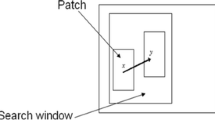Abstract
Texture segmentation is a very important subject in the fields of computer vision. In order to segment the textures, active contour model based on nonlocal means method and tikhonov regularization is proposed. In detail, a new nonlocal tikhonov regularization smoothness term is added. The nonlocal operator is based on the image slice similarity. So better segmentation accuracy can be achieved for the images which contain special texture features. The good matter of our method is not only nonlocal operator added but also the original tikhonov regularization smoothness item based on the pixel values retained. The nonlocal operator is time consuming, while the reserved smoothness term can save time to some extent. The traditional active contour model can only be used to segment the conventional images. The nonlocal active contour model can dispose the textures well. What’s more, in order to improve the computation efficiency, this paper designs the Split-Bregman algorithm. At last, our performance is demonstrated by segmenting many real texture images.


Similar content being viewed by others
References
Ambrosio L, Tortorelli VM (1990) Approximation of functionals depending on jumps by elliptic functionals via Gamma-convergence. Commun Pure Appl Math 43:999–1036
Bresson X, Chan TF (2008) Non-local unsupervised variational image segmentation models. CAM-report No.08-67
Bresson X, Esedoglu S, Vandergheynst P, Thiran JP, Osher S (2007) Fast global minimization of the active contour/snake model. J Math Imaging Vision 28(2):151–167
Chan TF, Vese LA (2001) Active contours without edges. IEEE Trans Image Process 10(2):266–277
Efros A, Leung T (1999) Texture synthesis by non-parametric sampling. In: International Conference on Computer Vision, p 1033–1038
Gilboa G, Osher S (2007) Nonlocal linear image regularization and supervised segmentation. SIAM Multiscale Model Simul (MMS) 6(2):595–630
Guodong W, Zhenkuan P, Qian D, Ximei Z, Zhimei Z, Jinming D (2014) Unsupervised texture segmentation using active contour model and oscillating information. J Appl Math 2014, Article ID614613, 11 pages
Martin D, Fowlkes C, Tal D, Malik J (2001) A database of human segmented natural images and its application to evaluating segmentation algorithms and measuring ecological statistics. In: Proceedings of the 8th International Conference on Computer Vision, p 416–423
Mumford D, Shah J (1989) Optimal approximation by piecewise smooth functions and associated variational problems. Commun Pure Appl Math 42:577–685
Paragios N, Deriche R (1999) Geodesic active contours for supervised texture segmentation. Proceedings of the IEEE Computer Society Conference on Computer Vision and Pattern Recognition (CVPR’99), p 699–706
Qiguang M, Cheng S, Pengfei X, Mei Y, Yaobo S (2011) A novel algorithm of image fusion using shearlets. Opt Commun 284(6):1540–1547
Qiguang M, Pengfei X, Tiange L, Yun Y, Junying Z, Weisheng L (2013) Linear feature separation from topographic maps using energy density and shear transform. IEEE Trans Image Process 22(4):1548–1558
Qiguang M, Ying C, Ge X, Maoguo G, Jiachen L, Jianfeng S (2015) RBoost: label noise robust boosting algorithm based on a non-convex loss function and the numerically stable base learners. IEEE Trans Neural Netw Learn Syst. doi:10.1109/TNNLS.2015.2475750
Savelonas MA, Iakovidis DK, Maroulis D, Karkanis S (2006) An active contour model guided by LBP distributions. Proceedings of the 8th International Conference on Advanced Concepts for Intelligent Vision Systems, p 197–207
Savelonas MA, Iakovidis DK, Maroulis D (2008) LBP-guided active contours. Pattern Recogn Lett 29(no. 9):1404–1415
Tomasi C, Manduchi R (1998) Bilateral filtering for gray and color images. International Conference on Computer Vision (ICCV), p 839–846
Yaroslavsky LP (1985) Digital picture processing, an introduction. Springer-Verlag
Acknowledgments
This work was supported by National Natural Science Foundation of China (No.61305045 and No.61170106), National “Twelfth Five-Year” development plan of science and technology (No.2013BAI01B03), Qingdao science and technology development project (No. 13-1-4-190-jch).
Author information
Authors and Affiliations
Corresponding author
Rights and permissions
About this article
Cite this article
Lu, J., Wang, G. & Pan, Z. Nonlocal active contour model for texture segmentation. Multimed Tools Appl 76, 10991–11001 (2017). https://doi.org/10.1007/s11042-016-3462-7
Received:
Revised:
Accepted:
Published:
Issue Date:
DOI: https://doi.org/10.1007/s11042-016-3462-7




